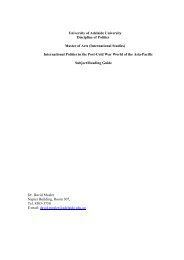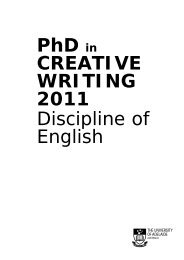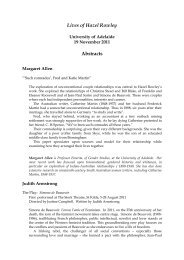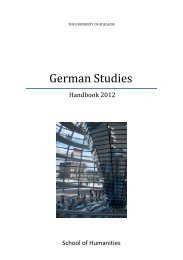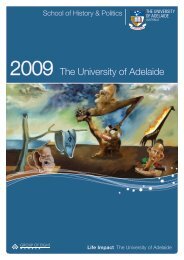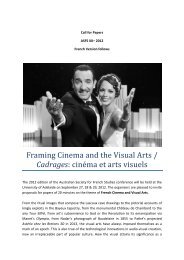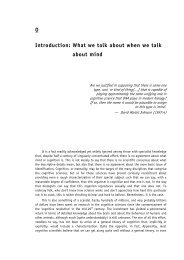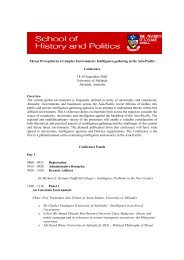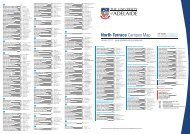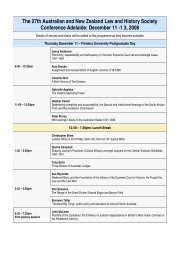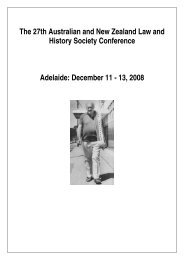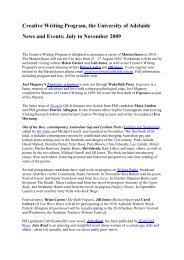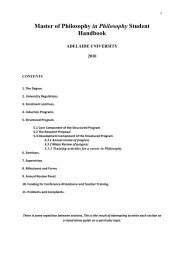Biohumanities - Paul Griffiths - Representing Genes
Biohumanities - Paul Griffiths - Representing Genes
Biohumanities - Paul Griffiths - Representing Genes
Create successful ePaper yourself
Turn your PDF publications into a flip-book with our unique Google optimized e-Paper software.
40 THE QUARTERLY REVIEW OF BIOLOGY<br />
Volume 83<br />
investigating complex diseases. For each<br />
disease we offered four strategies, designed<br />
to run along a continuum from focusing<br />
on the statistical relationship between gene<br />
and phenotype to entirely giving up on<br />
such a relationship in favor of analyzing<br />
content-dependent causal pathways between<br />
gene and phenotype. We looked for<br />
differences in which strategies were favored<br />
by biologists from particular backgrounds<br />
and also at whether the choice of<br />
strategies changed for human versus animal<br />
disease and for physiological versus<br />
psychological disease.<br />
1.2 the innateness study<br />
It is a truism that the term “innate” is<br />
vague and ambiguous. Matteo Mameli and<br />
Patrick Bateson have recently reviewed the<br />
scientific use of “innate” and identified no<br />
less than 26 proposed definitions of the<br />
term, of which they judge eight to be both<br />
genuinely independent definitions and potentially<br />
valuable scientific constructs (Mameli<br />
and Bateson 2006). However, the<br />
term “innate” remains immensely popular<br />
in psychology and cognitive science. Some<br />
philosophers have proposed that psychologists<br />
use the term to indicate that a question<br />
is not their concern and should be<br />
addressed to a biologist instead (Cowie<br />
1999, Samuels 2002). But other philosophers<br />
of science continue to propose analyses<br />
of the concept of innateness, designed<br />
to show that there is a single, coherent<br />
notion of innateness that either does or<br />
should underlie the use of the term in the<br />
sciences of the mind. These analyses are<br />
typically subject to intuitively compelling<br />
counterexamples from the proponents of<br />
alternative analyses.<br />
The aim of this study was to provide<br />
some solid evidence about the prescientific<br />
or “vernacular” understanding of innateness.<br />
To determine the factors affecting<br />
judgments of innateness, <strong>Griffiths</strong>, Edouard<br />
Machery, and Stefan Linquist examined<br />
the responses of biologically naïve<br />
subjects to a series of examples of the development<br />
of birdsong. Birdsong was used<br />
because it offered the best chance of finding<br />
closely comparable behaviors exhibiting<br />
every combination of the factors that<br />
earlier work had suggested would be relevant<br />
to judgments of innateness (<strong>Griffiths</strong><br />
2002).<br />
The results provided clear evidence that<br />
when people decide whether a trait is innate,<br />
they focus on two independent<br />
cues—whether the trait is universal and<br />
whether its development is sensitive to environmental<br />
influences. There is also tentative<br />
evidence that people may use a third<br />
independent cue, namely whether a trait<br />
has a designed purpose. In light of this, the<br />
authors argue in a forthcoming publication<br />
that current definitions of innateness<br />
have each defined it by using one of the<br />
cues but ignoring the others. This explains<br />
why intuitively compelling counterexamples<br />
to each definition can be found so<br />
easily, simply by choosing examples that<br />
make the other cue(s) salient.<br />
1.3. the philosopher as ecologist<br />
One motivation for the two empirical<br />
studies just described was to transcend the<br />
limitations of traditional conceptual analysis.<br />
The traditional method of devising a<br />
series of ingenious thought experiments<br />
too often ends with the proverbial “dull<br />
thud of conflicting intuitions” (Bigelow<br />
and Pargetter 1987). Experimental philosophy<br />
has the capacity to assess competing<br />
analyses against data and to avoid biases<br />
that are introduced by working with a single<br />
subdiscipline or a single school of<br />
thought in the science to be studied.<br />
Such philosophy “in the trenches” is in a<br />
privileged position to provide the bridge<br />
between philosophy and science, since its<br />
aim to provide biological knowledge unites<br />
it with science itself. At least part of philosophy<br />
of science has abandoned the idea<br />
that its job is to enforce rigor and precision<br />
within science through the stabilization<br />
and disambiguation of scientific meanings.<br />
This need not lead to <strong>Paul</strong> Feyerabend’s<br />
conceptual anarchism, in which the history<br />
of science is little more than a series of<br />
changes in the fashionable topics of scientific<br />
discussion (Feyerabend 1975). In<br />
place of these two unpalatable alternatives,<br />
we have come to appreciate that concep-



